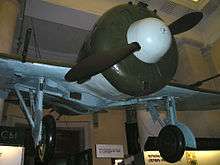Boris Safonov
| Boris Feoktistovich Safonov | |
|---|---|
 Boris Safonov in 1942 | |
| Born |
26 August 1916 Plavsky District, Tul'skaya oblast |
| Died | 30 May 1942 (aged 26) |
| Allegiance |
|
| Service/branch | Soviet Naval Aviation |
| Years of service | 1933-1942 |
| Rank | Lieutenant-Colonel |
| Unit | 72 SAP-SF, 78 IAP-SF |
| Commands held | 2 GSAP-SF |
| Battles/wars | German-Soviet War |
| Awards |
Order of the Red Banner (3) Distinguished Flying Cross (UK) |
Lieutenant-Colonel Boris Feoktistovich Safonov (Russian: Борис Феоктистович Сафонов); 26 August 1915 – 30 May 1942, was a Soviet Naval Aviation fighter ace of World War II.
Early life
He was born to a peasant family in the village of Sinyavino, now in the Plavsky District of Tula Oblast on 26 August 1915. After graduating from seven grades, he entered the Tula Railway Training College in the late 1920s. While studying at the college, he joined the local flying school, where his instructor was Valentina Grizodubova, who later became a celebrated military pilot. He was conscripted into the Red Army in 1933 and on completing his flying training at the Kacha Higher Military Aviation School, was posted to the Belorussian Military District. He served in the 106th Fighter Aviation Squadron named after Dzerzhinsky of the 40th Aviation Brigade from 1934. In 1939, he joined the Communist Party of the Soviet Union.[1] In 1940, he requested a transfer to the Northern Fleet Air Force.[2]
World War II

At the beginning of the German-Soviet War, Safonov was based at Vaenga (now called Severomorsk) on the Murmansk Front, commanding the 4th Squadron of the 72 SAP VVS VMF (72nd Mixed Aviation Regiment of the Soviet Naval Aviation) flying the Polikarpov I-16 fighter.[3] A widely circulated photograph of Safonov showed him with an I-16 bearing the slogan "For Stalin!" on its fuselage, although this probably wasn't his personal machine.[4] On 24 June 1941, he shot down a Junkers Ju-88 bomber on a reconnaissance flight; the first by the Northern Fleet.
In September 1941, No. 151 Wing RAF arrived at Vaenga by sea, with thirty nine Hawker Hurricane fighters which they were to train the Soviet personnel to operate and then hand over. Safonov headed the Soviet side of the training programme and made a good impression on his British colleagues, who remembered him as serious and likeable.[5] He took command of a new squadron, 78 IAP VVS VMF (78th Fighter Aviation Regiment of the Soviet Naval Aviation) which was formed to fly the Hurricanes and was largely manned by his pilots from 72 SAP VVS VMF. As a commander, he showed superb organisation and tactical skills, while enforcing strict discipline on his men, once threatening to shoot a pilot who he judged to have returned early from combat. However, he defended a colleague who accidentally shot down a friendly bomber and often gave others the credit for his own kills.[6]
In March 1942, Safonov returned as a lieutenant-colonel to command 72 SAP VVS VMF, now renamed 2 GvSAP VVS VMF (2nd Guards Mixed Aviation Regiment of the Soviet Naval Aviation). On 30 May, he took off for his 234th combat mission, flying a Curtiss P-40E to cover the approach of arctic convoy PQ-16. He shot down three Ju-88s but crashed into the sea following engine failure. The convoy escorts were unable to find him.[4]
Safonov's flying log shows his tally as 20 individual kills and 6 shared,[4] although he is believed to have actually scored 25 individual and 14 shared.[7] He was awarded the Order of the Red Banner three times (14 July 1941 22 December 1941 22 January 1942), the Order of Lenin (16 September 1941), Hero of the Soviet Union (16 September 1941 and 27 May 1942) and the British Distinguished Flying Cross.[8]
Remembrance

Safonovo, a village in the Severomorsk administrative area, is named after Safonov and has a bust of him at the entrance to the settlement. The street where he lived in Severomorsk is also named after him and his former home has a commemorative plaque attached. One of his I-16 aircraft is displayed in the Central Naval Museum in Saint Petersburg. An annual prize for the best naval pilot is also named after him.[8] Safonov's last regiment was renamed Red Banner, Safonov's Second Guards Fighter Aviation Regiment in his honour.[7]
References
- ↑ "Boris Safonov". Герои страны ("Heroes of the Country") (in Russian).
- ↑ "Boris Feoktistovich Safonov". www.2gvsap.org. Archived from the original on 2015-05-09. Retrieved 10 April 2015.
- ↑ Mellinger p. 8
- 1 2 3 Maslov p. 75
- ↑ Carter p. 211
- ↑ Mellinger pp. 8-9
- 1 2 Morgan p. 76
- 1 2 "Сафонов Борис Феоктистович". victory.sokolniki.com. Sokolniki Exhibition and Convention Centre. Retrieved 10 April 2015. (in Russian, an English translation is here)
Bibliography
- Carter, Eric and Loveless, Antony (2014) Force Benedict, Hodder & Stoughton, ISBN 978-1-44478514-2
- Maslov, Mikhail (2010), Polikarpov I-15, I-16 and I-153 Aces, Osprey Publishing, ISBN 978-1-84603981-2
- Mellinger, George (2006), Soviet Lend-Lease Fighter Aces of World War 2, Osprey Publishing, ISBN 978-1-84603041-3
- Morgan, Hugh (1997), Soviet Aces of World War 2, Osprey Publishing, ISBN 978-1-85532632-3